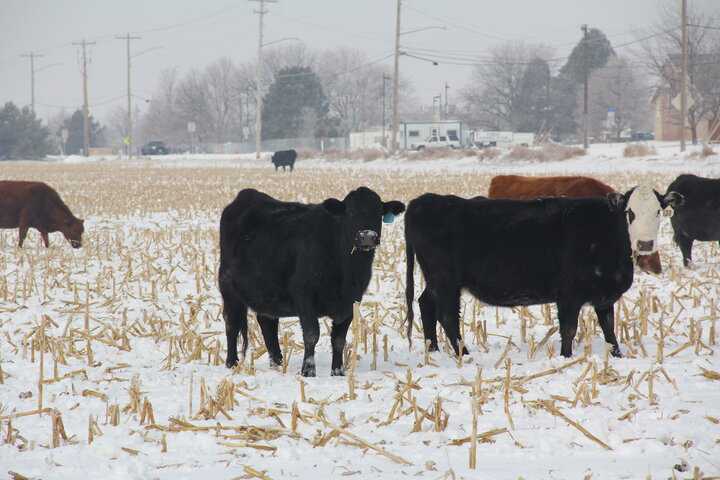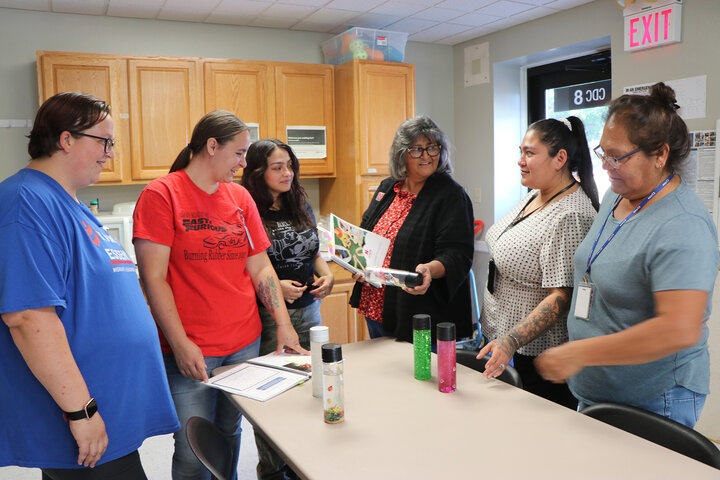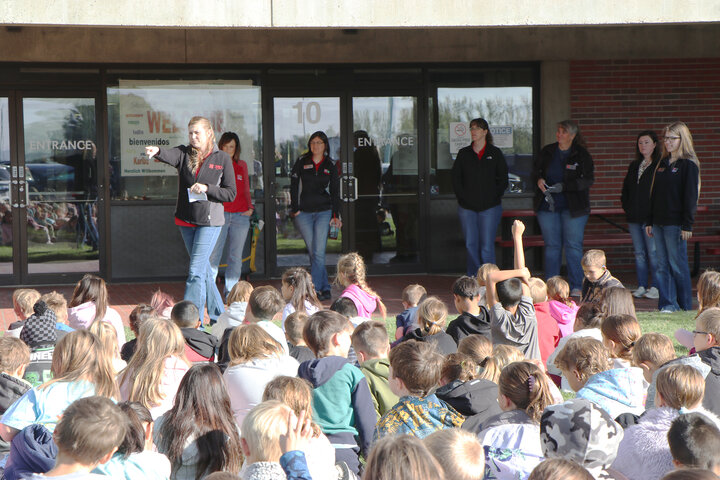Local Interest

Keys for Corn Stalk Grazing
By Aaron Berger, Nebraska Extension Educator
Nebraska has 10.5 million corn acres and 1.5 million beef cows - more than enough acres of corn residue for grazing beef cows through the winter.
Scouting fields before grazing is important to determine the amount of corn present and to look for spilled corn that could cause grain overload, which could result in cattle bloat or death. If there are more than 8-10 bushels of corn on the ground per acre as ears of corn, a grazing strategy to control corn intake will need to be used to minimize grain overload risk. When there is a minimum of ears of corn on the ground, the number of cattle to be grazed and the length of time for grazing should be determined based on corn bushel yield per acre and the average weight of cattle. The UNL Corn Stalk Grazing Calculator is an Excel® spreadsheet that can be used to calculate this. A quick way to estimate grazing days per acre available for a 1200-pound non-lactating cow is to take the corn bushel yield and divide by 3.5. For example, 180-bushel yield / 3.5 = 51 grazing days per acre.
Cattle tend to select for downed corn first and then seek out husk and leaves. The quality of grazing starts high at approximately 70 percent total digestible nutrients (TDN) and then decreases to a low of 45 percent TDN at the end of the grazing period. The rate of quality decline is dependent on stocking rate and environmental factors such as moisture and field conditions. Mature non-lactating, spring calving cows in a body condition score 5 or better will not need protein supplement, but will need salt, mineral, and vitamins when grazed at Nebraska Extension recommended stocking rates.
First-calf heifers within 90 days of calving will need protein and energy supplementation to meet nutrient requirements. Feeding 3.5 lbs. per head per day of dried distillers grains will meet this need. Fall-calving cows will also need additional protein and energy to meet nutrient requirements. Feeding 5 lbs. per head per day of dried distillers grains would supply this need. Grazing weaned calves with a targeted gain of one pound per day will need to be fed an energy and protein supplement. Research has demonstrated that dried distillers grains fed at 2 lbs. per head per day to calves will usually meet this targeted level of gain. Deep snow and ice can severely limit cattle's ability to graze corn residue. Have a backup plan and other feed resources available to meet cattle feed needs when this occurs. Corn residue can be an excellent, economical resource for late fall and winter grazing in many parts of the state.
nowing the keys for grazing can help producers effectively utilize it. The Nebraska Extension Circular Grazing Crop Residues with Beef Cattle provides additional information for grazing corn residue.

Resource developed to support workforce needs in childcare
Childcare can be an issue for many families. To meet this need, the initiative 6 Regions, One Nebraska Western Region has created a resource for employers. In the Western Region, employers are encouraged to explore childcare solutions through a new employer-focused guide to help address one of the most urgent challenges facing communities and local businesses: access to quality child care. The project was compiled by Jamie Bright, Rural Prosperity Nebraska Extension Educator, as part of the region’s ongoing work to strengthen the workforce and support local economic growth.
During regional discussions held in the Panhandle, business leaders, educators, and community partners identified childcare as a significant barrier to workforce participation and business expansion. In response, the regional leadership team sought practical ways to engage employers in the solution. The new resource guide provides awareness, data, and actionable childcare strategies for businesses of all sizes.
“When parents can’t find childcare, employers lose workers. We have heard this message over and over again from businesses and communities across the region,” said Bright. “This guide gives employers clear options — from flexible scheduling to childcare partnerships — so they can play a proactive role in keeping parents in the workforce.”
The guide includes:
- Data illustrating the economic impact of childcare shortages in Nebraska
- Examples from Nebraska employers who have implemented childcare solutions
- Practical strategies businesses can adopt at various investment levels
- Steps to assess workplace needs and get started
- Local and statewide resource contacts for ongoing support
The 6 Regions, One Nebraska Western Region hopes the resource will raise awareness, spark employer involvement, and inspire collaborative approaches to a system-wide challenge.
“Businesses can’t afford to ignore the issue of childcare. When parents don’t have options, employers lose talent, productivity, and momentum,” Bright said. “By working together, we can support working families, strengthen businesses, and grow thriving communities.”
The complete guide, Enhancing Workplace Support: A Guide for Businesses on Employee Child Care Needs, is now available to employers, chambers, economic development organizations, and community partners throughout the region.
The 6 Regions, One Nebraska, is a statewide initiative to promote economic development through regional partnerships and collaboration.
For more information or to receive the guide, contact Bright at jamie.bright@unl.edu

The 2025 Scotts Bluff County 4-H Achievement Program was held on October 19 at the UNL Panhandle Research Extension and Education Center in Scottsbluff. The event recognized the progress and growth of 4-H members and encouraged them to continue their development in life and leadership skills to become productive citizens. Adults were also recognized for providing youth development experiences and leadership to our clubs and members.
“By participating in club and project work, trips offered through the county, state, and nation, youth get to meet many new people, have chances to work together in close group atmospheres, and enhance their life skills,” said Audra Brown, 4-H Assistant.
The awards and recipients are as follows:

Nebraska Extension early childhood educator passionate about building strong families
By Chabella Guzman, PREEC Communications
Many Nebraska Extension educators are called to their positions. Jackie Guzman is no exception. She is the Nebraska Extension early childhood educator and lead educator in the Nebraska Extension Engagement Zone 1, located at the University of Nebraska-Lincoln Panhandle Research Extension and Education Center in Scottsbluff.
“It is a purpose, a calling for me. This is where we need to start with parents and children to build a solid foundation, where the children are ready to learn and more apt to graduate,” she said.
Among the programs Guzman provides to professionals is the CHIME (Cultivating Healthy Intentional Mindful Educators) program. It is an eight-week program that focuses on the person working with young children, providing them with the skills to work effectively with children by first helping themselves through mindfulness.
Guzman has developed and implemented programs for non-traditional audiences while incorporating traditional 4-H curriculum and methodologies for youth. One such program is embryology, which includes Extension 4-H educators. “I provide incubators, and the farmers provide eggs. There is a curriculum with activities for elementary school children and early childhood/preschool programs,” she said.

Second graders engage with agriculture at annual AgSplosion Field Day
By Chabella Guzman PREEC Communications
The annual AgSplosion Field Day welcomed 190 second graders on Tuesday, October 14, to the University of Nebraska-Lincoln at the Panhandle Research Extension and Education Center in Scottsbluff. The 4-H Ag Literacy event rotated the students through eight stations to learn more about agriculture in their surrounding communities.
“We teach second graders about agriculture, specifically within the Panhandle,” said Audra Brown, Nebraska 4-H Extension Assistant. “The students learn about agricultural commodities within the Panhandle, from beans to corn, and beef to dairy cattle. They are exposed to what is being produced in agriculture right here in their backyard.”
The event was held in early October across the Nebraska Panhandle. Elementary schools from Bridgeport, Chadron, Chappell, Hemingford, Mitchell, Minatare, Morrill, and Scottsbluff participated in field days in their areas. A 4-H team was created from extension assistants in the surrounding counties. They created a schedule, contacted schools, and then came together to help staff the stations at each field day to ensure a successful event.
The stations included: beef, dairy, dry beans, potatoes, wheat, and their many products; corn, and the Nebraska Corn Board; and ag technology used by producers. The swine session, which explained commercial swine operations, was led by Brown.
“They really enjoy looking at the model swine barn - the comment I hear the most is ‘wow that's a lot of pigs in there!’ Having a physical model helps them to better understand what a farm looks like,” she said. The students were surprised to learn that pig heart valves can be used to replace damaged or diseased heart valves in humans, which function in much the same way. The students also learned about by-products that come from swine, such as chewing gum, crayons, and drumheads.
Sponsors this year included: Corn Board Grant, Morrill County Farm Bureau, Nebraska Dry Bean & Lentil Commission, Oshkosh Heifer Development (donating dairy station supplies), Scotts Bluff County Farm Bureau, and Walthers Farms (donating the potato chips).



